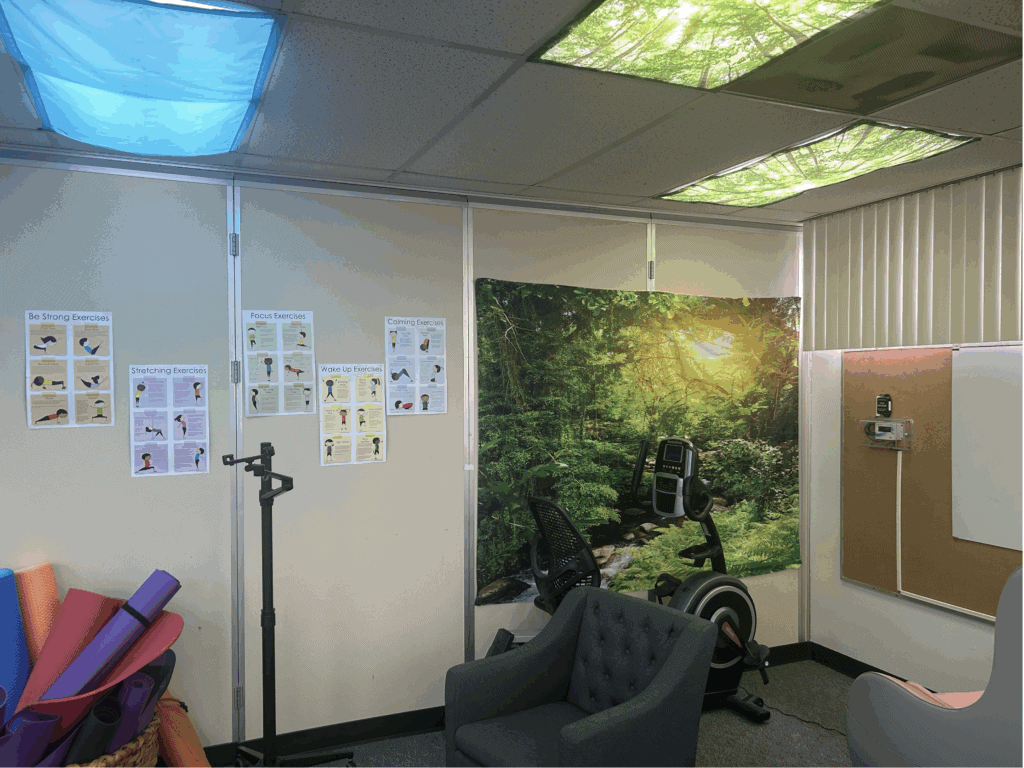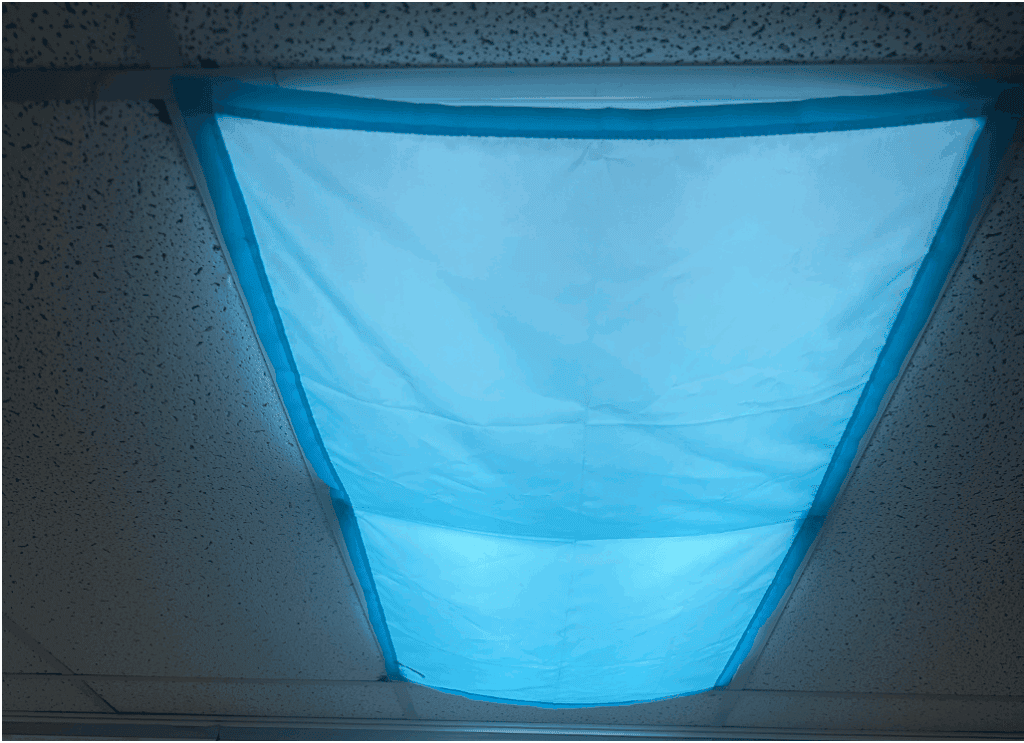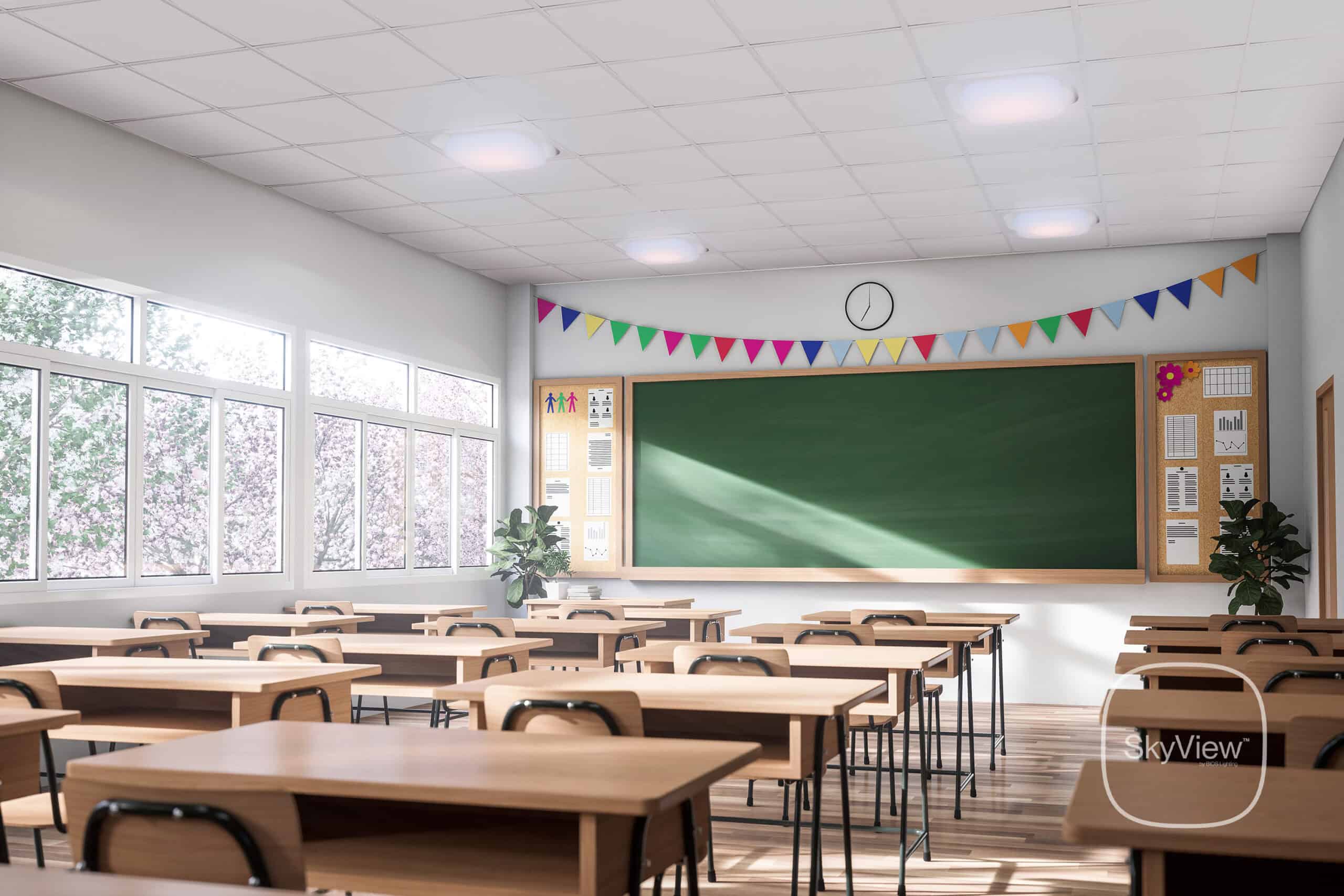Wellness and calming rooms are increasingly common in K–12 schools and hospitals to reduce stress, improve focus, and support emotional well-being. These spaces often include sensory tools, comfortable seating, and adjustable lighting. However, lighting is typically limited to changes in color or brightness, lacking the high-melanopic circadian lighting crucial for supporting, mood, alertness and regulating biological rhythms—especially important given that most classrooms and offices have bright but sky-blue-deficient lighting.
The Rise of “Wellness”, “Calming”, and “Peace Rooms”
Wellness rooms (also known as calming or peace rooms) were developed for nurses, teachers, staff and students as dedicated spaces designed to reduce stress, support emotional regulation, and improve overall well-being. Initially developed to support the high stress nursing environment as well as neurodiverse and trauma-effected student populations, such wellness rooms are increasingly ubiquitous and used by all to various effect.
In schools, “peace corners” or entire separate wellness rooms allow students, teachers and staff to take short breaks, practice mindfulness, or reset during moments of emotional overwhelm—helping them return to class ready to learn with minimal disruption. For example, the San Antonio Independent School District’s “peace rooms” feature soft lighting, bubble tubes, weighted plush toys, and aroma diffusers, and are reported to help students de-escalate stress in the moment. In K-12 settings, wellness rooms contribute to improved student behavior, emotional self-regulation, and, ultimately, school climate (Buckner 2022).
In healthcare, similar spaces—including quiet rooms and serenity rooms—serve staff and patients alike. Staff use them to decompress during breaks, reducing burnout and increasing compassion satisfaction (Mileski et al. 2024). These rooms often incorporate soothing décor, soothing music, aromatherapy, and soft lighting to create a spa-like refuge amid high-stress environments.
Although data is limited, the perceived effectiveness of many wellness room applications is mixed (Dorr 2024). The idea of an isolated wellness space is typically received positively but the measured psychological outcomes and user comments suggest more could be done. Something is missing.
Tools and Strategies Used in Wellness Spaces
Wellness and calming rooms commonly include sensory elements to engage multiple modalities. These may feature:
- Reduced lighting intensity, colored light filters, or soft colored accent lamps.
- Comfortable furniture like beanbags, massage chairs, or sound-insulated pods
- Multi-sensory tools such as aromatherapy diffusers, weighted objects, bubble tubes, textured surfaces, or ambient soundscapes
- Aerobic exercise equipment
- In schools, simple mindfulness tools—like coloring books, zen gardens, breathing exercises, or teaching modules on emotion identification—are added for self-regulation
These wellness spaces are valued for lowering anxiety, supporting emotional balance, and offering a restorative break from stress, especially for individuals facing heightened emotional challenges.
Lighting in Wellness Rooms: Limited to Mood, Not Biology
Lighting in these environments is often focused on mood and ambiance—dimmed, warm, or softly colored. The change in light is meant to provide a sense of separation from the standard classroom or school hallway (Buckner 2022). Indeed, great emphasis has been placed on room colors and illumination in classrooms and hospitals based on fundamental beliefs of the effects of color on psychology and physiology in built spaces (see reviews by Gains & Curry 2011 and Chang & Xu 2019). Overall, strong scientific evidence for colored filters in modulating mood and focus is limited and mixed.
But while perhaps visually calming, filtered standard lighting lacks scientifically-backed circadian support. Traditional LED or fluorescent lighting in classrooms and hospital offices may feel bright but typically does not deliver the “sky-blue” melanopic spectrum needed to support circadian rhythms for boosted mood and daytime cognitive performance (Lo Verso et al. 2023).
Color and intensity manipulations, such as dimming or using warm hues, may help create a soothing atmosphere but do not address the biological signaling that underpins alertness, mood regulation, or sleep-wake cycles—a serious oversight in environments where stress, focus, and mood are key.
Take for example a typical K-12 school staff wellness room shown below.

Note the emphasis on biophilic colors, comfortable surroundings and stress-relieving activities. Lighting is typically colored and muted, with natural light from the windows blocked out. Ironically, the best source of mood-improving high-melanopic light would be coming from the window. The standard modern LED lighting is poor in 490nm (sky-blue) wavelengths as shown in a spectrophotometric measure below.

Overall, the horizontal surface light averaged 263 lux, while the vertical plane melanopic light averaged an abysmal 79 lux (m-EDI). Given the daytime melanopic light recommendation is >250 m-EDI (Brown et al. 2022), this wellness room is a mere 31.6% of the healthy light threshold needed to maintain circadian health.
A close up measurement of light from a blue filtered LED troffer tile shows, not surprisingly, that from one meter away the photopic (horizontal) illuminance is 323 lux while the vertical melanopic (vertical) illuminance is still only 173 lux (m-EDI), 69% of the recommended threshold. In general, the lighting filters reduce overall illumination modestly and change the spectral appearance to provide “softer, colored light for calming”, but the light engine is still a standard fluorescent or LED fixture.

True Circadian Lighting Integration in Wellness Rooms
Colored lighting can influence mood and atmosphere, but strong scientific support for its calming effect on staff or students is lacking. If the goal is to enhance alertness, supports stress management, and optimize performance—especially in educational or healthcare settings—a biologically based lighting approach (with controlled melanopic content) is far more impactful than purely aesthetic color cues.
Research in both school and clinical environments shows that increased exposure to melanopic-enriched spectra either by daylighting or circadian light has clear benefits in reducing stress and boosting mood while improving physical recovery and cognition Cajochen et al. 2019; West et al. 2019; Kytka 2020; Ezpeleta et al. 2021).
Wellness rooms with embedded circadian lighting strategies—bright, sky-blue enriched during the day, and warmer, blue-depleted in the evening—could:
- Accelerate emotional recovery and reduce stress more effectively
- Boost cognitive resilience and learning readiness in school settings
- Support better healing environments and staff well-beings in hospitals
By updating room lighting to include biologically relevant spectra, these spaces would optimize both acoustics and ambiance and physiological performance.
Wellness and calming rooms are modern, needed sanctuaries in our schools’ and hospitals’ built environments—but lighting in these places hasn’t caught up to the science. By adopting affordable, energy-efficient, easily-installed circadian-optimized lighting like SkyView™ Tile, organizations can multiply the benefits of these rooms, turning them into both sensory and physiological havens.
References
Brown TM, Brainard GC, Cajochen C, Czeisler CA, Hanifin JP, Lockley SW, Lucas RJ, Münch M, O’Hagan JB, Peirson SN, Price LL. Recommendations for daytime, evening, and nighttime indoor light exposure to best support physiology, sleep, and wakefulness in healthy adults. PLoS biology. 2022 Mar 17;20(3):e3001571.
Buckner L. Calming spaces in schools and classrooms. California Center for School Climate at WestEd. https://ca-safe-supportive-schools. wested. org/wp content/uploads/2022/10/Calming-Spaces-in-Schools-and-Classrooms. pdf. 2022.
Cajochen C, Freyburger M, Basishvili T, Garbazza C, Rudzik F, Renz C, Kobayashi K, Shirakawa Y, Stefani O, Weibel JJ. Effect of daylight LED on visual comfort, melatonin, mood, waking performance and sleep. Lighting Research & Technology. 2019 Nov;51(7):1044-62.
Chang B, Xu R. Effects of Colors on Cognition and Emotions in Learning. Technology, Instruction, Cognition & Learning. 2019 Oct 1;11(4).
Dorr A. Introducing a Relaxation Room Bundle to Relieve Stress on Nurses: A Quality Improvement Project (Doctoral dissertation, Jacksonville University).2024.
Ezpeleta S, Orduna-Hospital E, Solana T, Aporta J, Pinilla I, Sánchez-Cano A. Analysis of photopic and melanopic lighting in teaching environments. Buildings. 2021 Sep 27;11(10):439.
Gaines K, Curry Z. The inclusive classroom: The effects of color on learning and behavior. Journal of Family and Consumer Sciences Education. 2011;29(1).
Kytka BI. Measuring the effect of pro-cognitive light on the performance of secondary school students. 2020.
Lo Verso VR, Giovannini L, Valetti L, Pellegrino A. Integrative lighting in classrooms: preliminary results from simulations and field measurements. Buildings. 2023 Aug 22;13(9):2128.
Mileski M, McClay R, Kruse CS, Topinka JB, Heinemann K, Vargas B. Using serenity rooms and Similar tools to improve the workplace during COVID-19: a rapid review. Nursing Reports. 2024 Feb 5;14(1):376-89.West A, Simonsen SA, Jennum P, et al. An exploratory investigation of the effect of naturalistic light on fatigue and subjective sleep quality in stroke patients admitted for rehabilitation: A randomized controlled trial. NeuroRehabilitation. 2019;45(2):187-200. doi:10.3233/NRE-192752


